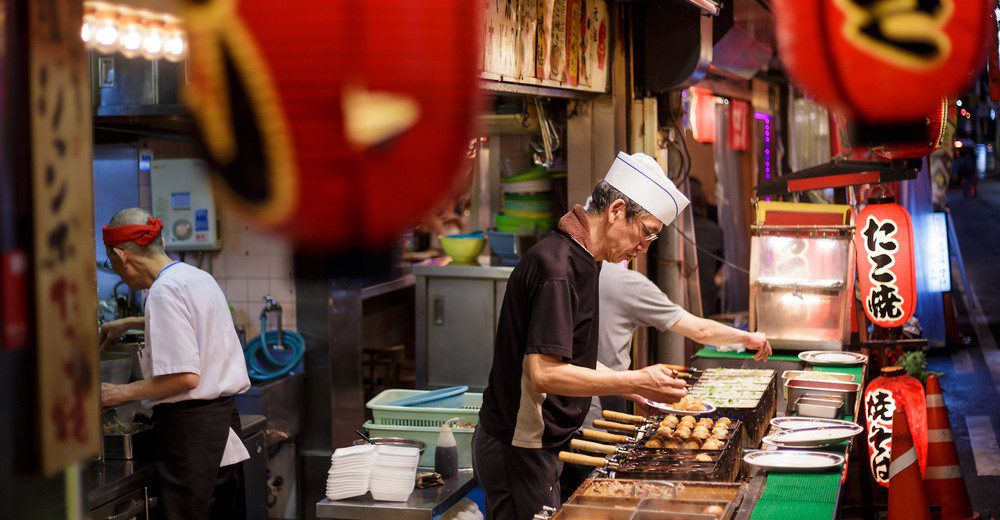Japan has a rich and influential culinary culture that’s based on centuries of tweaking and refining its cuisine until it’s as close to perfection as possible – in that true Japanese spirit.
And in no two other cities will you come face to face with the legacy of this enduring culinary culture than in Osaka and Kyoto.
Osaka is known as the foodie capital of Japan – its nickname is “tenka no daidokoro” (the nation’s kitchen) – and is home to many regional specialities that draw even Tokyo-ites to town.
And Kyoto, as Japan’s former capital and seat of the imperial court for over a thousand years, isn’t too shabby itself when it comes to its food scene. It’s here that you’ll find kyo-ryori, considered by many to be the pinnacle of refined Japanese cuisine.
Here’s a mouth-watering guide to both of these culinary capitals for your next trip to Japan, and make sure you read until the end where you can find out how you can win a trip to Japan on an exciting famil hosted by JNTO.
Osaka – Where to go?

You really are spoilt for choice when it comes to filling your belly in Osaka, a city of passionate food lovers with an abundance of things to eat. And you won’t have to try very hard at all to stumble upon some choice examples of delectable Japanese cuisine.
But, if you want to dine where the locals dine, then make your way over to the area known as Dōtonbori – THE entertainment, nightlife and food hub of Osaka. From regional specialities to Japanese staples, you could literally eat yourself into a serious food coma here.
The Namba/Shinsaibashi area and the streets and lanes surrounding Osaka/Umeda stations are also popular places to feast yourself silly.
Don’t leave without trying…

Takoyaki
Also known as “octopus balls,” these delectable little ball-shaped Japanese snacks are typically filled with minced or diced octopus, pickled ginger, and green onion, and are brushed with takoyaki sauce (similar to Worcestershire sauce) and mayonnaise. The batter is made from a wheat flour-based batter and they are cooked in a specially moulded pan.
To finish off, they are sprinkled with green laver (aonori) and shavings of dried bonito.
Okonomiyaki

Basically a savoury pancake filled with a variety of different ingredients – such as green onion, meat (generally thin pork belly), octopus, squid, shrimp, vegetables, konjac, mochi (rice-cake) or cheese – this regional speciality is extremely popular in Osaka. Indeed, it’s often referred to as a “Japanese pizza.”
The batter is made of flour, grated nagaimo (a type of yam), water or dashi, eggs and shredded cabbage.
There are two main types of okonomiyaki, Kansai-style (found in Osaka and the Kansai region) and Hiroshima-style, found in Hiroshima and surrounding areas.
Kushikatsu

Consisting of deep-fried battered skewered chicken or pork, seafood and veggies, this dish is widely popular in Osaka. Kushikatsu may be served straight or with tonkatsu sauce.
Kyoto – Where to go?

Japanese food is very regional.
While there are certain dishes and ingredients that are common throughout the entire country, each region has its own specialities, ingredients and techniques. And as the traditional heart of Japan, Kyoto’s food scene pays tribute to the country’s enduring cuisine legacy – be it on a smaller and more intimate scale.
To get a taste (literally) of what this city has to offer, head down to Nishiki Market in downtown Kyoto and amble around its narrow lanes that contain over 100 shops and restaurants. Or stroll down the quaint streets of Gion and spot geishas, then stop for some matcha (powdered green tea) and Japanese sweets.
Other areas popular with foodies include Pontocho, which is one of Kyoto’s most atmospheric dining areas with several traditional tea houses, and Arashiyama, where you can sample different types of street food.
Don’t leave without experiencing…

Kaiseki ryori
A traditional multi-course Japanese dinner that consists of a sequence of dishes, each often small and artistically arranged, this dining experience is an art form that balances the taste, texture, appearance, and colours of the food served to you.
Shojin ryori

This type of cuisine is a style of Buddhist vegetarian cooking which uses fresh seasonal ingredients and gentle seasoning.
Obanzai ryori
Nothing beats a home cooked meal, no matter where you are. Obanzai ryori is traditional cuisine that’s been passed down through the generations of Kyoto locals.
Kawayuka/kawadoko

Don’t leave Kyoto without having at least one meal dining on an outdoor platform built over flowing water. This dining experience is only possible during summer.
READ: BEYOND THE TASTE: Iconic Japanese dishes that demand to be devoured
READ: LOST IN TRANSLATION: Bill Murray’s guide to Tokyo


